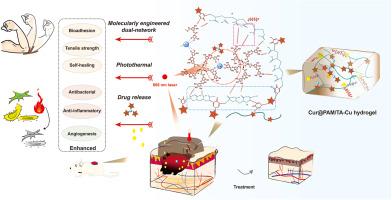Molecularly engineered dual-network photothermal hydrogel delivery system with enhanced mechanical properties, antibacterial ability and angiogenic effect for accelerating wound healing
Abstract
Bacterial infection caused by trauma and chronic wounds in the most mobile area remains a challenge in clinic. It is difficult to achieve the synergistic effects of antibacterial capacity and skin regeneration using conventional therapeutic methods. Developing a multi-functional hydrogel dressing that can cope with the complex wound environment will contribute to the healing and therapeutic effects. In this work, a novel Cur@PAM/TA-Cu photothermal hydrogel delivery system was prepared by engineering tannic acid (TA) into covalent cross-linked polyacrylamide (PAM) on which the chelating tannic acid-copper metal–polyphenolic network (TA-Cu MPN) was imposed to form dual-crosslinked networks, and the natural medicine curcumin was loaded eventually. The molecularly engineered dual-crosslinked networks resulted in enhanced mechanical properties including bio-adhesion, tensile strength and self-healing, which made the hydrogel suitable for dynamic wound and various application scenarios. In addition, the excellent photothermal capacity, antioxidant effect and biocompatibility of the hydrogel were demonstrated. Notably, this curcumin loaded photothermal hydrogel exhibited superior antibacterial capacity (almost 100% killing ratio to E. coli and S. aureus) under 808 nm laser irradiation. Meanwhile, the in vivo wound healing experiment results revealed that the anti-inflammation and proangiogenic effect of Cur@PAM/TA-Cu hydrogel successfully shortened the healing time of wound and the reconstruction of skin structure and function. Thus, this dual-crosslinked multi-functional hydrogel delivery system is a promising wound dressing for accelerating wound healing.


 求助内容:
求助内容: 应助结果提醒方式:
应助结果提醒方式:


